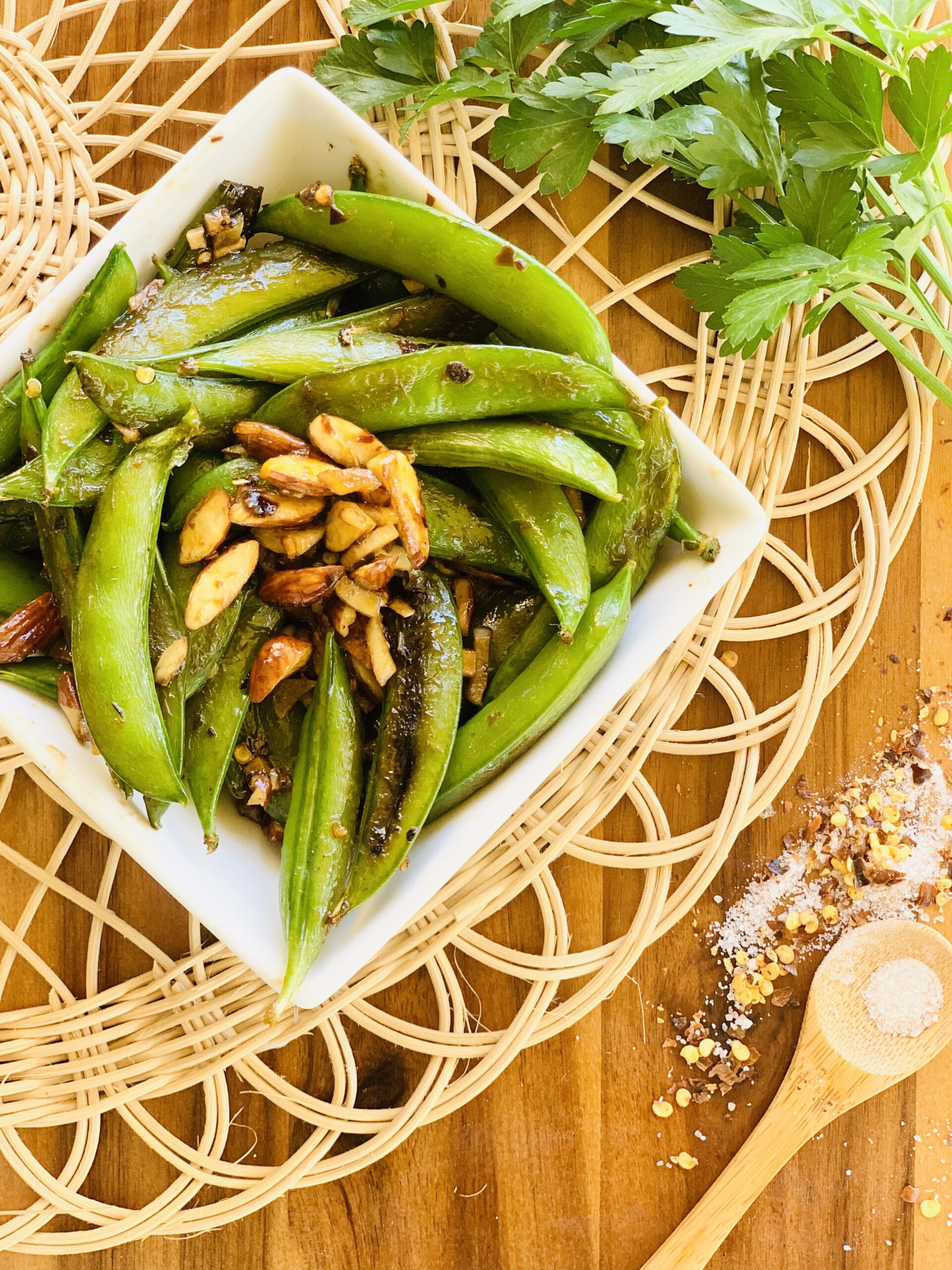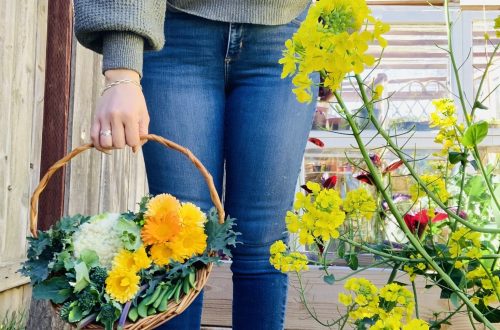If I could pick one thing to grow year round, sugar snap and snow peas would be pretty high up on that list. There is just something so breath taking about growing it up an arbor and having all those pods hanging from the vines. Even more rewarding is to be able to snack on them and use in all sorts of delicious dishes. Like my sweet and spicy snap pea recipe! -Its finger licking good!

Snap vs. snow peas?
The biggest difference is the size of the pea and pods. Snow peas are flat and slender these are grown mostly for the tender pod rather than the pea inside. I’m growing green beauty snow peas they are a heirloom variety that can get up to 8 in long! They have showy purple flowers that turn blue as they fade. Very sweet and crunchy they can be eaten raw or cooked. This has been my preferred variety for several years.
Snap peas are shorter and the pea inside gets big and plump. The variety I’m growing is sugar snap these are perfect for snacking on, tender and crisp.
Did you know that snap peas are the result of crossing snow peas with the good old shelling pea?
There are so many varieties of peas to grow coming in golden, purple and green shades. I’ve even seen some dwarf varieties in the market that grown in a bush habit, perfect for small spaces. Definitely shop around for a variety that suits your growing space. Growing snap and snow peas is very hands off and the best part is that they don’t have to be shelled.

*Pictured above are snow peas on the top half and snap peas on the bottom.
Snap pea and snow pea growing guide
As with all my grow guides I will share my experience and planting dates for my area (zone9b) The growing information shared will be useful to ANY gardener in ANY area. The only thing that may differ is planting dates, based on your local climate and zone.
Seed starting – For my zone 9b friends, I direct sow my first batch of peas in late October-November. Our winters are mild and peas can handle a light frost. Peas are a cool season crop that is hardy down to 28 degrees Fahrenheit. They do grow a bit slower through fall and winter because the days are shorter. Once the spring days hit they explode with new growth. Overwintering some of my pea plants let’s me have an early harvest once spring arrives. In my climate often time spring temperatures start warming up too fast for peas to thrive so getting a head start is very convenient.
I succession sow more seeds in December-January as the days get longer they grow rapidly! I like to elongate my pea season as much as possible. I grow this cool season crop fall-spring, my summer heat is too intense for peas and they struggle when temps hit over 80 degrees Fahrenheit .
For my gardeners in colder climates its best to wait until the soil is workable to direct sow. Keep in mind that early plantings may take a bit longer to germinate, but will tolerate cool spring temperatures as long as its not a severe frost. (direct sow 4-6 weeks before your last spring frost if soil is workable) Starting seeds indoors is possible but peas do not like their roots disturbed just be extra careful when transplanting. If starting indoors use fluffy soil, keep the pea seeds moist and covered with a humidity dome (plastic wrap is a good option for small pots) until they sprout. One thing I will recommend is starting them in a pot they can grow into that way you don’t disturb the roots by up potting. Once sprouted provide them with a light source such as grow lights. Place pea seedlings in the garden once the weather is over 40 degrees Fahrenheit, peas are one of the early crops you can get into the garden.
When your plants are ready to be transitioned to the garden begin the hardening off process. That simply means exposing them to the outdoors a little bit at a time, I like to do 1 hour increments for the first week.
Spacing and location- This is one plant that does extremely well with intensive planting. I place seeds about 1- 2 inch apart and 1/2 in deep. They begin sprouting in about 7-14 days.
*Good rule of thumb is to plant seeds twice deep of their size. Seeds have limited energy to pop through the soil, planting too deep may inhibit the seed from germinating successfully
Sun requirements and temperature-Choose a spot with 6-8 hours of full sun. Ideal temperature for peas is 40-70 degrees Fahrenheit.
Soil- Well draining soil that is enriched with compost or organic matter
Pruning– Are you guys ready for the one tip that can double your pea harvest?… drumroll please…. pinching your peas, yes although it seems a bit daunting to prune plants. I promise you it will be worth it. Pinch the top off your peas once your plants are 6-8 in. tall. Within a few weeks you will notice there will be new growth near the lower set of leaves (nodes) This means that every new side shoot will produce more blooms and in turn will end up with bigger pea harvests!
Pests & Disease- While there is a whole list of virus, bacterial and fungi diseases that can affect growing pea plants. Keeping a close eye on your plants to see if there is any change in leaf texture, color, can help catch anything early and manage diseases if they arise. The only disease I have personally dealt with on my snap peas is Powdery mildew its a fungal disease that is prevalent in wet humid environments. We had record rain this year here in California and the plants took a hit. Plants had white “powder like blotches” on the top and underside of leaves. To keep this from spreading I pruned off affected leaves and treated with a biological plant protectant from Arber.
In terms of pests I haven’t had much issues, except the very unusual one we had this year, any guesses? Yup birds! They were not eating the pods but rather the foliage. The plants were established and it didn’t seem to phase them. In future years I may have to consider using bird netting.
Support- Pea plants are climbers they need some sort of support so they can wrap their tendrils and hold themselves up. This can be anything from a hand made trellis, arch, cattle panel arch works wonderful! They may need a little help weaving through the trellis, for those stubborn plants that wont stay put I use zip ties!
Watering– it is easier to underwater than to overwater. Pea plants require constant moisture. They are fast growers and need constant water to keep up.
Fertilizing- Use a good balanced fertilizer every month to give them a dose of nutrition. I prefer organic solutions like fish emulsion or plant food.
Harvesting- Harvest snap pea pods when they are around 2 inches long and nice and plump. Snow peas grow larger and can be harvested once they have a good size to them. Harvesting often signals the plants to keep producing all season long.
Growing peas has been such a joy! I hope this guide is helpful and you give them a little corner in your garden this season. If you are a new gardener don’t be scared to make mistakes, every year we learn a little more!
Happy Growing -Tahiri






